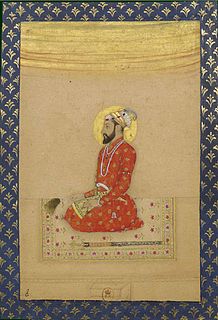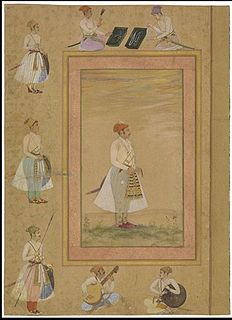
Shivaji Bhosale I was an Indian warrior-king and a member of the Bhonsle Maratha clan. Shivaji carved out an enclave from the declining Adilshahi sultanate of Bijapur that formed the genesis of the Maratha Empire. In 1674, he was formally crowned as the chhatrapati (emperor) of his realm at Raigad.

Sambhaji Shivaji Bhosale was the second ruler of the Maratha kingdom. He was the eldest son of Shivaji, the founder of the Maratha Empire and his first wife Saibai. He was successor of the realm after his father's death, and ruled it for nine years. Sambhaji's rule was largely shaped by the ongoing wars between the Maratha kingdom and Mughal Empire as well as other neighbouring powers such as the Siddis, Mysore and the Portuguese in Goa. In 1689, Sambhaji was captured, tortured and executed by the Mughals, and succeeded by his brother Rajaram I.

Bahadur Shah, also known as Muhammad Mu'azzam and Shah Alam was the seventh Mughal emperor of India, ruled from 1707 until his death in 1712. In his youth, he conspired to overthrow his father Aurangzeb, the sixth Mughal emperor, and ascend to the throne. Shah's plans were intercepted by the emperor, who imprisoned him several times. From 1696 to 1707, he was governor of Akbarabad, Kabul and Lahore.

Netoji Palkar (1620–1681) was a Sardar Senapati or Sarnaubat (Commander-in-Chief) under Chhatrapati Shivaji, founder of the Maratha empire.

Sinhagad is a hill fortress located at around 35 km southwest of the city of Pune, India. Some of the information available at this fort suggests that the fort could have been built 2000 years ago. The caves and the carvings in the Kaundinyeshwar temple stand as proofs for the same.

Murarbaji Deshpande was a general in the early Maratha Empire during the reign of Shivaji. He is best remembered for his defense of the Purandar Fort against Dilir Khan, a Mughal general who accompanied Mirza Raja Jai Singh in the 17th-century siege on Purandar.

Mirza Raja Ram Singh I was the elder son Mirza Raja Jai Singh I and was ruler of Amber, and head of the Kachwaha Rajput clan, from 1667 to 1688. He was subehdar of Kashmir from 1675-1680.

The Treaty of Purandar was signed on June 11, 1665, between the Rajput ruler Jai Singh I, who was commander of the Mughal Empire, and Maratha Chhatrapati Shivaji Maharaj.Chhatrapati Shivaji was forced to sign the agreement after Jai Singh besieged Purandar fort. When Chhatrapati Shivaji realised that war with the Mughal Empire would only cause damage to the empire and that his men would suffer heavy losses, he chose to make a treaty instead of leaving his men under the Mughals.
Santaji Mahaloji Ghorpade,(1645-1696) popularly known as ‘Santaji’ or ‘Santaji Ghorpade’, was one of the greatest warriors and the chief General of the Maratha Empire during Chhatrapati Rajaram’s regime. His name became inseparable from the name of Dhanaji Jadhav with whom he made campaigns against Mughal Army continuously from 1689 to 1696. He is considered to be one of the most foremost exponents of ganimi kava(guirella warfare).

Maharaja Jai Singh was a senior general of the Mughal Empire and a ruler of the kingdom of Amer. His predecessor was Raja Bhau Singh who ruled 1614-1621.

Shankaraji Narayan Gandekar (1665–1707), also known as Shankaraji Narayan Sacheev or Shankarajii Narayan, was a popular Minister (Pradhan) and Count (Sardar) of the Maratha Empire. He also served as Imperial Secretary (Sacheev) during Emperor Chhatrapati Rajaram’s reign. He also served as Deputy to the Crown (Rajadnya) under Emperor Sambhaji. His contribution to the war of independence against Mughal rule is considered to be immensely supportive. He was also the founder of the princely state of Bhor located in Pune district.

Purandar Fort is known as the birthplace of Chhatrapati Sambhaji Maharaj, the son of Chhatrapati Shivaji Maharaj. The fort is repeatedly mentioned in the rising of Shivaji Maharaj against the Adil Shahi Bijapur Sultanate and the Mughals. The fort of Purandhar stands at 4,472 ft above the sea level in the Western Ghats, 50 km to the southeast of Pune.
Bapuji Mudgal Deshpande was a general in the early Maratha Empire during the reign of Shivaji.
The Siege of Purandhar occurred in the summer of 1665 and was initiated by the Mughal Emperor Aurangzeb, after the Maratha leader, Chhatrapati Shivaji maharaj, sacked the Mughal imperial port city of Surat. Shivaji continued to raid Aurangabad and attacked Mughal ships in the Indian Ocean. In response, Aurangzeb sent one of his most experienced commander Mirza Raja Jai Singh.
The Battle of Purandar was fought between the Mughal Empire and Maratha Empire in 1665. The Mughal Emperor, Aurangzeb, sent his general Jai Singh to besiege Shivaji's fortress at Purandar. After Mughal forces killed Maratha General Murarbaji on June 2nd, 1665, Shivaji surrendered and gave up 23 of his fortresses. Most of the fortresses were later recaptured by Marathas.
The Battle of Salher which was a battle fought between the Maratha Empire and the Mughal Empire in February 1672 CE. The battle was fought near the fort of Salher in the Nashik district. The result was a decisive victory for the Maratha Empire. This battle is considered particularly significant as it is the first battle in which the Mughal Empire lost on an open field.

Tanhaji: The Unsung Warrior is a 2020 Indian Hindi-language biographical period action film directed by Om Raut and produced by Bhushan Kumar, Krishan Kumar and Ajay Devgn under T-Series Films and Ajay Devgn FFilms. Tracing the life of Maratha warrior Tanaji Malusare, it stars Ajay Devgn in the titular role along with Saif Ali Khan and Kajol in the lead roles. It also features Sharad Kelkar and Luke Kenny in the pivotal roles. Set in the 17th century, it revolves around Tanaji's attempts to recapture the Kondhana fortress once it passes on to Mughal emperor Aurangzeb who transfers its control to his trusted guard Udaybhan Singh Rathore.
Siege of Ramsej (1682-1688) was a series of military confrontations between Maratha empire headed by Sambhaji and Mughal empire led by Aurangzeb regarding the control of Ramsej fort in the Nashik region. Aurangzeb arrived in Deccan in late 1681 with a 5,00,000 strong army to destroy the Maratha Empire and the Deccan Sultanates of Adilshahi and Qutubshahi. He wanted to capture the forts held by the Marathas in Nashik and Baglana region. Hence he decided to begin his Deccan campaign with an attack on Ramsej fort which is near Nashik.
Maratha occupation of Kolwan in the year 1672 was a campaign in which the Maratha army under Shivaji's son Sambhaji and Peshwa Moropant defeated the allied forces of Koli kings of Jawhar and Ramnagar and the Mughal Empire. The Marathas captured the region called Kolwan encompassing the Jawhar, Mokhada, Wada, Talasari, Vikramgad talukas in present day Palghar district of Maharashtra and the regions Southern Gujarat controlled by the Koli king of Ramnagar.











